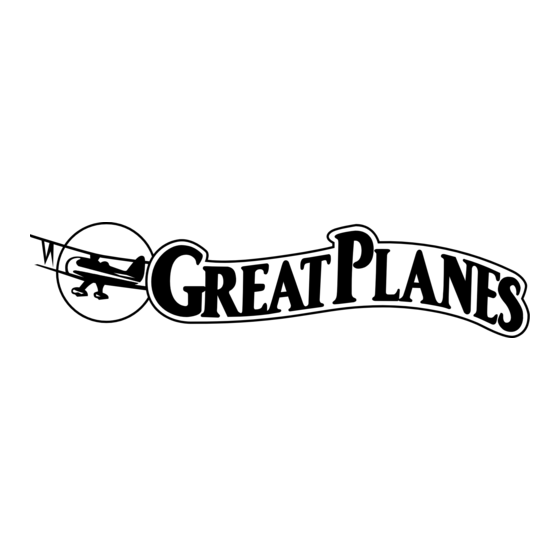GREAT PLANES Fling DL ARF Інструкція з експлуатації - Сторінка 12
Переглянути онлайн або завантажити pdf Інструкція з експлуатації для Іграшка GREAT PLANES Fling DL ARF. GREAT PLANES Fling DL ARF 16 сторінок.

4-CHANNEL
TRANSMITTER
4-CHANNEL
TRANSMITTER
4-CHANNEL
TRANSMITTER
Set the Control Throws
Use a Great Planes AccuThrow
measure and set the control throw of each control surface as
indicated in the chart that follows. If your radio does not have dual
rates, we recommend setting the throws at the high rate setting.
These are the recommended control surface throws
Low Rate
ELEVATOR
1/4" [6mm] up
1/4" [6mm] down 3/8" [9.5mm] down
AILERONS
3/8" [9.5mm] up
3/8" [9.5mm] down 5/8" [16mm] down
RUDDER
1/4" [6mm] right
1/4" [6mm] left
IMPORTANT: The Fling DL ARF has been extensively
flown and tested to arrive at the throws at which it flies
best. Flying your model at these throws will provide you
with the greatest chance for successful first flights. If,
after you have become accustomed to the way the Fling
DL ARF flies, you would like to change the throws to suit
your taste, that is fine. However, too much control throw
could make the model difficult to control, so remember,
"more is not always better."
Balance the Model Laterally
❏
1. With the wing level, have an assistant help you lift the
model by the tip of the fuse and the bottom of the fin. Do this
several times.
❏
2. If one wing always drops when you lift the model, it
means that side is heavy. Balance the airplane by adding
weight to the other wing tip. An airplane that has been
laterally balanced will track better in loops and
other maneuvers.
❏
3. Make certain that the
control surfaces respond in
the correct direction as
shown in the diagram. If
any of the controls respond
in the wrong direction, use
the servo reversing in the
transmitter to reverse the
servos connected to those
controls. Be certain the
control
surfaces
have
remained centered. Adjust
if necessary.
™
(or a ruler) to accurately
High Rate
3/8" [9.5mm] up
5/8" [16mm] up
3/8" [9.5mm] right
3/8" [9.5mm] left
PREFLIGHT
Identify Your Model
No matter if you fly at an AMA sanctioned R/C club site or if
you fly somewhere on your own, you should always have
your name, address, telephone number and AMA number
on or inside your model. It is required at all AMA R/C club
flying sites and AMA sanctioned flying events. Fill out the
identification tag on the back cover and place it on or inside
your model.
Charge the Batteries
Follow the battery charging instructions that came with your
radio control system to charge the batteries. You should
always charge your transmitter and receiver batteries the
night before you go flying, and at other times as
recommended by the radio manufacturer.
CAUTION: Unless the instructions that came with your
radio system state differently, the initial charge on new
transmitter and receiver batteries should be done for 15
hours using the slow-charger that came with the
radio system. This will "condition" the batteries so that
the next charge may be done using the fast-charger of
your choice. If the initial charge is done with a fast-
charger, the batteries may not reach their full capacity
and you may be flying with batteries that are only
partially charged.
Range Check
Ground check the operational range of your radio before the
first flight of the day. With the transmitter antenna collapsed
and the receiver and transmitter on, you should be able to
walk at least 100 feet away from the model and still have
control. Have an assistant stand by your model and, while
you work the controls, tell you what the control surfaces are
doing. If the control surfaces do not respond correctly, do
not fly! Find and correct the problem first. Look for loose
servo connections or broken wires, corroded wires on old
servo connectors, poor solder joints in your battery pack or
a defective cell, or a damaged receiver crystal from a
previous crash.
12
